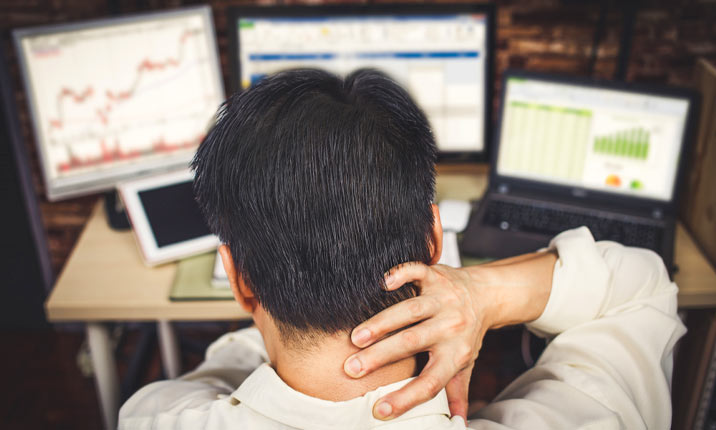
How to Avoid Work-From-Home Body Aches?
28 Oct 2021
As work from home becomes a new norm, more people have had complaints of back pain or neck and shoulder aches. If these symptoms sound familiar, find out how you can treat and gain relief from these niggling pains and aches.
The past year of COVID-19 has seen many of us carve out makeshift spaces in our homes to do the work that we would otherwise be doing in the office. For many who do not have the luxury of space, this means that we are confined to our work stations and seated for long hours in front of our screens, with less chances for movement and healthy exercise. After a long day of work, we may often find our bodies aching and hurting.
What’s causing these aches and pains?
You may be experiencing aches and pains due to:
- Poor ergonomics of make-shift working areas at home
- Prolonged hours of sitting with insufficient breaks in between
- Sedentary lifestyle from lack of exercise and not commuting to work
- Repetitive strain injury from keyboard typing or use of mouse
- Underlying conditions such as previous injuries of the back or joints, or underlying arthritis
The most common issues that people experience after long hours of computer use from working from home are neck, shoulder and back aches, as well as elbow, wrist and finger pain.
Neck aches and back aches

Poor sitting posture can cause neck pain, due to the excess strain placed on the muscles and ligaments supporting your neck. The pain can worsen when you engage in certain movements, such as turning your neck in a certain direction.
A prolonged or poor posture while sitting can also result in back pain, due to the strain placed on the intervertebral discs in our spine, which are the fluid-filled cushions in our back that protect our vertebrae from rubbing together. You may experience upper, mid or lower back pain. In addition to poor posture, upper back pain is typically caused by muscle tension from looking downwards at your device for long periods of time.
Wrist, finger and elbow conditions
De Quervain’s tendinitis
Wrist pains are usually caused by a strain or inflammation of the tendon at the side of the wrist. De Quervain’s tendinitis is a condition where the tendon controlling movements of the thumb is affected, and there is pain at the side of the wrist near the thumb. Symptoms of De Quervain’s tendinitis include swelling and pain near the base of your thumb, and difficulty grasping or pinching with your fingers.
Trigger finger
Trigger thumb or trigger finger is a condition where the tendons controlling the flexion of the thumb and fingers are affected. It is caused by inflamed tendons in the hands where the swollen tendons can no longer slide easily through the tunnel of tissues in the hand. When the condition is prolonged, there might be pain and a clicking sound when the fingers are flexed.
Carpal tunnel syndrome
Carpal tunnel syndrome is a condition where there is compression of the median nerve in the wrist, which controls the movement of the thumb and fingers, and gives sensation to the skin of the palm and fingers. Some symptoms of carpal tunnel syndrome include numbness, tingling, and weakness in the hand.
Tennis elbow
Tendons around the elbow may get inflamed from prolonged repetitive use. A common elbow condition is tennis elbow, which is caused by inflammation of the tendon on the outside of the elbow. Pain over the outer side of the elbow can then be triggered by certain movements.
Simple exercises for stretching your muscles

Try doing these simple neck stretches when you take your work breaks:
Forward and backward tilt
Start with your head in a neutral position and slowly lower your chin toward your chest and hold for 15 – 30 seconds. Relax, and slowly lift your head back up. Next, tilt your chin toward the ceiling and hold for 10 seconds, and return to the start position.
Side rotation
From a neutral position, gently tilt your head toward your right shoulder and try to touch it with your ear. Stop once you feel a stretch in your neck muscles, and hold this position for 5 – 10 seconds before returning to the start position. Repeat on your left side.
Repeat each neck stretching exercise 3 times.
For those with aching and tight back muscles, try these easy back stretches:
Standing back stretch
While standing, slowly bend forwards with a relaxed neck and your arms hanging loosely by your side. Keep your legs straight with a slight bend at the knees and your eyes on the ground. Once you feel a stretch in your lower back muscles, stop and hold this position for 10 seconds. You should not feel any pain in your back. Slowly return to a neutral upright position.
Next, gently bend backwards gradually with your hands on your hips to maintain balance. Once you feel a stretch in your lower back muscles or the front of your hips, stop and hold this position for 10 seconds. As earlier, you should not experience any pain when stretching. Again, slowly return to a neutral upright position.
Knee-to-chest stretch
Lie down on a comfortable surface with your knees bent and feet planted on the ground. While lying down, grasp one of your legs with both hands under the knee and bring your flexed knee towards your chest. Hold this position for 30 seconds, then slowly bring your knee down to a resting position with your foot on the ground. Repeat on the other side.
Repeat each back stretching exercise 3 times.
How can the pain be managed?

Here are some tips to relieve, reduce and avoid getting these aches and pains.
- Adjust your workstation to an ergonomic position. Your screen should be at eye level and around an arm’s length away. Ensure your wrists are straight, and your hands at the level of your elbow. Adjust your chair height such that both your feet are resting on the ground or supported with a foot rest.
- Remember to take regular breaks from your work, at a minimum of 5 minutes every hour. Combat back pain while working by taking short breaks often, rather than longer ones less often. For example, 5 – 10 minutes every hour is better than 20 minutes every 2 hours. Get up from your chair and move around the house. This allows you to exercise different muscles and increase your blood circulation, while also allowing you to take an ‘eye break’ and rest your eyes to reduce eye strain.
- Modify your usual activities to avoid actions that can aggravate and worsen the pain, such as lifting heavy objects and activities that require repetitive gripping and twisting of the hand and wrist.
- Use a wrist guard, finger splint or elbow brace to protect the wrist, fingers and elbow during movement and help reduce tendon inflammation.
- Take oral and topical painkillers such as Paracetamol and Non-Steroidal Anti-Inflammatory Drugs (NSAIDs) if necessary to help relieve the symptoms temporarily and reduce tendon inflammation. If you have a drug allergy or any underlying medical condition such as chronic kidney or gastric issues, do make sure to check with the pharmacist or your doctor on what pain relief medication and NSAIDs would be suitable for you to take.
- Seek treatment and consult your doctor if your condition persists despite taking the above measures. Other treatment options that your doctor may recommend include physical therapy, local injections for the affected areas to relieve inflammation, and surgery for prolonged conditions.
Don’t delay seeking treatment for prolonged pain
If you have been experiencing prolonged pain and discomfort in your neck, back, wrist, hand or elbow that does not improve despite modifications to your posture and activities, do consult a doctor to rule out any serious underlying conditions such as injury to your nerves or muscles. Further evaluation by your doctor may be needed to rule out conditions such as a pinched nerve or disc disorder. Your doctor will be able to recommend a range of suitable treatments including physical exercises, medication and surgery to help improve and treat your condition.
Article contributed by Dr Wong Pei Ying, family physician at Parkway Shenton, Singapore Telecom
References
Christensen, E. (2021, May 27). How to do a lower back stretch safely. Retrieved August 17, 2021, from https://www.wikihow.com/Do-a-Lower-Back-Stretch-Safely
De Quervain's tenosynovitis. (2020, July 23). Retrieved August 17, 2021, from https://www.mayoclinic.org/diseases-conditions/de-quervains-tenosynovitis/symptoms-causes/syc-20371332
Eidelson, S. G., & Cristol, H. (2021, April 5). Upper Back Pain Causes, Risk Factors, Diagnosis and Treatment. Retrieved August 17, 2021, from https://www.spineuniverse.com/conditions/upper-back-pain
Hedge, A. (2019, March 9). Workstation ergonomics: Take a break! Retrieved August 17, 2021, from https://www.spineuniverse.com/wellness/ergonomics/workstation-ergonomics-take-break
Mallen, C. D., Chesterton, L. S., & Hay, E. M. (2011). Management of tennis elbow. Open Access Journal of Sports Medicine, 2011(2), 53-59. doi:10.2147/oajsm.s10310
Moretti, A., Menna, F., Aulicino, M., Paoletta, M., Liguori, S., & Iolascon, G. (2020). Characterization of home working population during covid-19 emergency: A cross-sectional analysis. International Journal of Environmental Research and Public Health, 17(17), 6284. doi:10.3390/ijerph17176284
Morse, R. G. (2019, May 20). Why Does My Lower Back Hurt When I Sit and How Can I Relieve the Pain? Retrieved August 17, 2021, from https://www.healthline.com/health/lower-back-pain-when-sitting
Working safely with display screen equipment. (n.d.). Retrieved August 17, 2021, from https://www.hse.gov.uk/msd/dse/work-routine.htm




